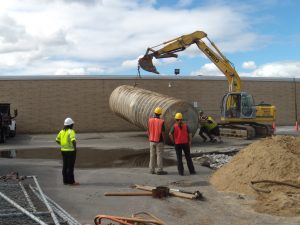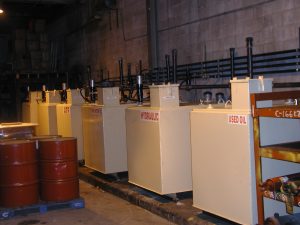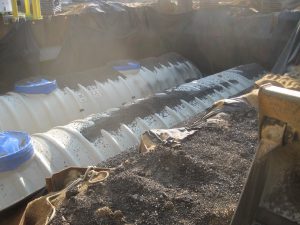Petroleum and Chemical Bulk Storage Decisions
 If you plan to store petroleum products or certain types of hazardous substances, you can count on detailed regulation whether you choose above ground or underground storage tanks (ASTs or USTs). Stringent standards are aimed at overall public health and environmental protection, but primarily ensuring that our groundwater remains safe, because half the nation’s drinking water comes from this source.
If you plan to store petroleum products or certain types of hazardous substances, you can count on detailed regulation whether you choose above ground or underground storage tanks (ASTs or USTs). Stringent standards are aimed at overall public health and environmental protection, but primarily ensuring that our groundwater remains safe, because half the nation’s drinking water comes from this source.
An underground storage tank (UST) is defined by the US Environmental Protection Agency as any tank and connecting underground piping that holds at least ten percent of its combined volume underground. The EPA regulates all USTs used to store specified hazardous substances or petroleum.
Above ground storage tanks (ASTs) also have to meet EPA Spill, Prevention, Control and Countermeasure standards, regulations that cover tank design, construction and installation as well as ongoing monitoring and inspection, and clean-up if a spill occurs.
Who regulates underground and above ground storage tanks?
New York and New Jersey are part of EPA Region 2. Compliance monitoring is handled by each state – the New York Department of Environmental Conservation Petroleum Bulk Storage Program or the New Jersey Department of Environmental Protection UST or LUST (leaking UST) Programs.
In addition, your county, municipality and/or fire department may modify or add to the EPA’s requirements. Fire codes usually indicate whether ASTs are allowed, and they typically define the type of equipment you need, maximum capacity, fire resistance level and minimum distance needed to separate tanks from one another, buildings, property lines, public areas and dispensing equipment.
ASTs are gaining official acceptance. Whether they will be approved for your location depends on what you plan to store, the location and size of your tanks and whether your product is being sold at retail or used only for private motor-vehicle fueling.
Above ground storage tanks are often preferred for bulk storage of chemicals and fuels.
 It’s less costly to install an AST. You can place the tank on a pad or footing, so you’ll need far less excavation and the corresponding backfill and paving. You can easily perform a visual check for leaks because ASTs are situated in a diked environment or above grade.
It’s less costly to install an AST. You can place the tank on a pad or footing, so you’ll need far less excavation and the corresponding backfill and paving. You can easily perform a visual check for leaks because ASTs are situated in a diked environment or above grade.
Under some circumstances, ASTs don’t necessarily have to be fire-rated. And they’re comparatively easy to move, especially the smaller sizes.
New ASTs are now required to be constructed of steel. Underground storage tanks may be constructed of steel or fiberglass, and tanks are also available in a composite design where the steel is coated with fiberglass or corrosion-resistant urethane.
What’s trending with storage tanks?
 Larger size, for one thing, to facilitate future expansion if your fuel storage needs increase. Planning ahead saves money in the long run.
Larger size, for one thing, to facilitate future expansion if your fuel storage needs increase. Planning ahead saves money in the long run.
Secondary containment is becoming more widely required. These tanks cost more up front but provide better protection against environmental contamination in the event of a leak. The Comprehensive Environmental Response, Compensation and Liability Act (CERCLA) and Code of Federal Regulations (CFR) require secondary containment for some hazardous substances.
Compartmentalized USTs are growing in popularity. They are less expensive to install because you need less excavation, backfill and paving for just one rather than several tanks and because they enable onsite blending of different fuel grades.
Not sure whether underground or above ground storage tanks are right for your application?
If you can answer “yes” to all these questions, above ground storage tanks probably make good sense for your installation:
- Permitted by zoning regulations, or a variance might be possible?
- Sufficient land available to accommodate tanks now and for future needs?
- Aesthetically appropriate?
- Can meet required environmental protection and secondary containment?
- Spill control sufficient to avoid fire explosions?
- Adequate protection from vandals or other tampering?
- Design can efficiently support product storage and transfer?
- Financially feasible?
If one of more of these key factors doesn’t work, you’ll likely need to install underground storage tanks instead.
Still aren’t sure what to choose, ASTs or USTs?
Curious about your site? Give us a call!
(516) 624-7200 – Long Island / 5 Boroughs
(845) 745-0888 – Hudson Valley
(518) 698-3012 – Capital District
And check out Walden’s recent underground storage tank removal video. Or click here to see all of our tank-related services.
